If there’s one thing about me it’s that I’m selectively obsessive. When I made pita bread and 3 out of 8 pita breads puffed up, I obsessively made pita bread again and again until 100% of the batch puffed up.
Every time a pita bread did not puff up, the steam that should have been trapped in the pita pocket went instead to my head. And the incessant beeping of the fire alarm certainly did not help.
But my silent infuriation has passed, because this very specific pita-frustration was easily fixed by knowledge of why a pita bread puffs up and why it doesn’t. After much experimentation, I have figured out the best way to cook pita bread for a 100 percent puff rate. Now, I expect ALL my future pita bread to puff up and I hope that yours do too.
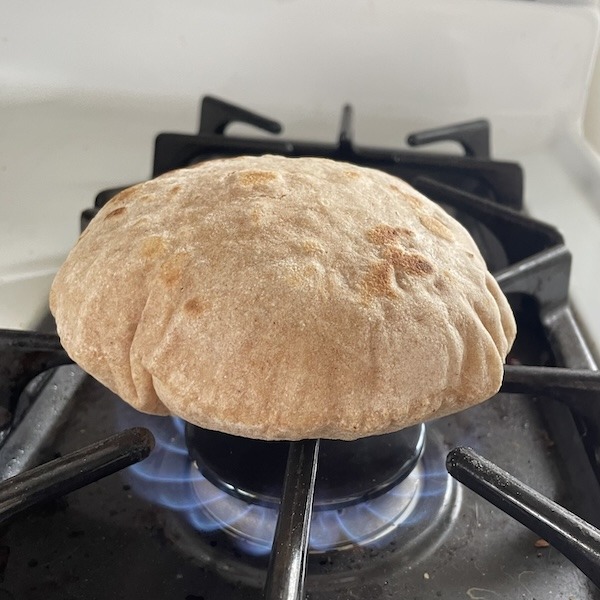
In short: What causes pita bread to not puff up?
- A tear in the bread during rolling or handling – this could be caused by inadequate gluten development, lack of flouring, or rough handling.
- Not being cooked quickly enough – this could be caused by insufficient heat or unsuitable thickness.
Pita bread should always puff up if these two major components are satisfied (granted, there are many contributing factors within each).
Need a pita bread recipe? Try my 100% Whole Spelt Sourdough Pita Bread.
In short: The best method for making pita bread (requires open flame)
After dividing dough, form into balls, making sure that the seams are pinched tight. Press down into patties, then roll out into 3-5mm thick circles, lightly flouring and turning/flipping the entire time.
Heat up a flat pan or tawa over medium high heat (7-8 out of 10). Gently transfer rolled out pita to the pan, cook 30-40 seconds each side. There should be some minor bubbles and grooves in the flatbread but no major puffing at this point. Turn off the heat.
Gently move the par-cooked pita bread onto a gas burner. Ignite the flame to high (8-9 out of 10); the pita should puff up almost immediately (within 1 or 2 seconds) and steam profusely. Cook the pita for 20-30 seconds, and then flip and cook 20-30 seconds on the other side, moving the pita around with a pair of metal tongs or chopsticks as needed for even charring. Turn off the flame. The pita is now done, and the other pitas can be rolled out and cooked in the same fashion.
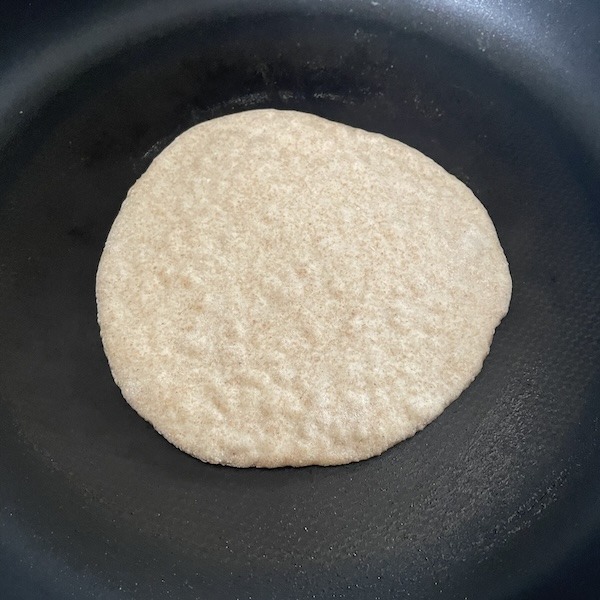
Further tips:
When moving the pita bread around, be careful not to puncture the pita, as that will allow steam to escape. If the pita is punctured or bursts and loses steam, it is not a big deal as long as the pita has steamed long enough to cook the insides. I find that leaving the pita alone during the initial burst for 20-30 seconds before flipping is enough to steam the inside of the bread provided that the pitas are rolled out thin enough.
Testing pita bread techniques
I conducted a variety of tests in search of the optimal pita puffing technique. Immediately below you will find a summary of my findings. Scroll on (or click each highlighted subsection in green) to read about each test in detail.
Summary
- Floured vs non-floured: light flouring when rolling out the dough is ideal.
- Second proof vs no second proof: no discernable difference.
- Rolling out thin vs rolling out thick: pita bread rolled out 3-5mm thick had the most consistent puff.
- Cooking in the oven vs on a regular pan vs on a cast iron pan: the best method is cooking lightly (30-40 seconds) in a regular pan before moving to an open flame to char and puff (20-30 seconds each side). The second-best method is cooking in a lightly oiled pan.
1. Rolling floured vs non floured
I never flour dough when forming sourdough loaves, so I was a bit sceptical about flouring when rolling out pita. However, a light flouring does indeed help prevent pita bread from tearing, which is essential to achieving the puff.
You may find that with adequate gluten development and fermentation, the dough is smooth and strong enough to roll thinly without flour. However, I would still caution against this because it is extremely easy to produce microscopic tears in the skin of the pita bread when rolling and when transferring the rolled-out dough from the counter onto the pan.
In my test batch of pita bread made without flouring, only 2 out of 8 pita breads puffed up completely. Some pita bread puffed up partially, and the others were varying amounts of flat.
Be sure not to over flour as that will encourage dry craggy bits to form, which will also lead to cracking of the pita bread.
The best way is to dust with flour continuously when rolling and flipping the pita, while dusting off excess flour each time additional flour is added.
2. Second proof vs no second proof
I found that a second proof after dividing the dough was not necessary. There was no discernable difference between rolling and cooking the pita immediately after preforming and allowing the balls of dough to rest for 30 minutes. The rested dough was perhaps easier to roll out (due to relaxation of gluten), but this did not affect the puff rate of the pita.
3. Rolling out thin vs rolling out thick
Pita bread rolled out 3-5mm thick had the most consistent puff. I would not recommend rolling more than 5 mm thick. Even if you use someone else’s recipe, it is a good idea to use one which specifies thickness instead of diameter, as measuring by diameter may yield unreliable results if dough is not accurately divided.

If pita bread is not rolled out thin enough it may not cook fast enough. High heat and the rapid expansion of steam are what allows pita bread to puff up.
On the other hand, pita bread rolled too thin is liable to tearing and drying out (on the counter and in the pan).
4. Oven vs regular pan vs cast iron pan
I tested a variety of cooking methods: from baking pita bread in a hot oven, to using various sorts of pans, to using an open flame. Here are the methods I tested, ranked from best to worst:
Best: parcooking in a regular pan then finishing over an open flame
This method of cooking provided the best results. I first read about this method in a post on Tori Avey’s website.
The par-cooking open flame method is summarized in the summary section above. After some experimentation, I have made the following adjustments and clarifications to the open flame method:
- During the first step, only lightly sear the pita. The purpose of this step is to stiffen the skin of the pita, so it does not collapse when we cook it over the open flame. The purpose is not to cook it completely. There should be some minor bubbles, but the pita bread should still be able to lie flat on the pan.
- Instead of moving the parcooked pita to an already burning flame, I like to put the pita on the range and then turn on the gas. The added flare from the ignition of the flame helps radically puff up the pita.
- After further testing for specificity regarding medium high heat and high heat, I have found that for my gas range, pita bread cooks best on setting 7 or 8 (out of 10) for the first step on the pan. The best setting for the open flame step is a 8 or 9 (out of 10). Your individual appliances may vary.
The best part about the open flame method is that it doesn’t get my fire alarm going because the cooking time is short and controlled, much unlike the oven and cast iron pan methods.
Second: regular pan or tawa with light oil
The open flame method may be inaccessible if you don’t have a gas range. Pita bread can still be cooked successfully on the stove top with an electric range. However, the pan method did not give me a 100% puff rate like the open flame method did. (With this method, perhaps only around 40% of pitas puffed up completely, the others were in varying degrees of half-puffiness).
For this method, pita bread is cooked in a preheated and lightly oiled pan over medium high heat, for around 1-2 minutes on each side. The pita should puff up around the 1-minute mark, and you should continue to cook the pita, flipping as needed to achieve the desired charring. Gently pressing on the areas of the pita that have not puffed may encourage it to puff up completely – but be careful not to puncture the pita.
In my tests, I found that pita bread cooked in a regular pan non-stick pan was softer than those cooked in a cast iron.
A light oiling may help with heat conductivity. However, be sure not to over oil, as that will lead to cracking of the pita.

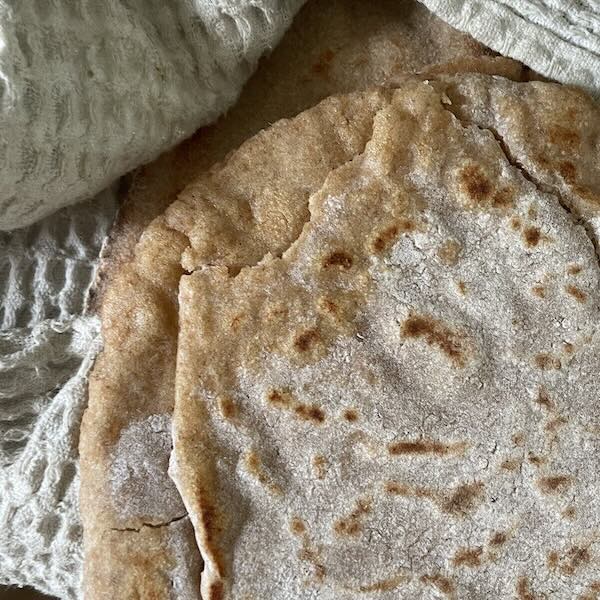
Less than ideal: cast iron pan on the stovetop
Cooking in a cast iron pan over the stove top produced puffed up pita bread, but overall, the pita bread was too dry and crusty. (For me, the cast iron pan led to around an 75% puff rate.)
Why would cast iron be worse than a regular pan? The answer lies in heat transference. Because the cast iron was able to retain heat, but not conduct heat as effectively as the regular pan, it produced pita bread that had a hard crust and even browning. These browning and crusting attributes are desirable in a sourdough loaf, but less desirable for flatbread, where we want some sporadic charring on otherwise soft, pliable bread.
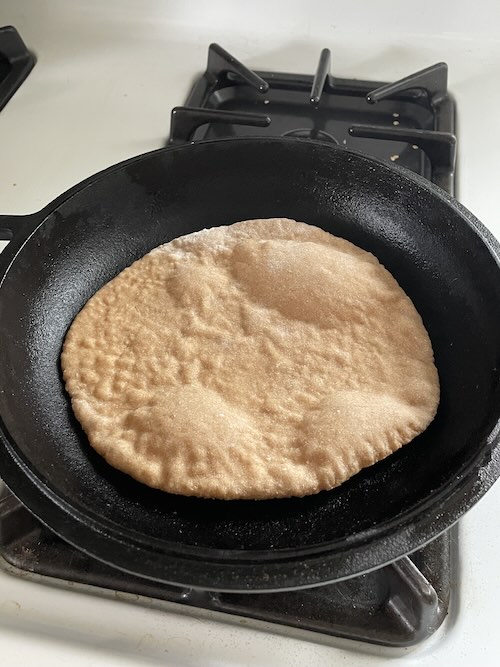
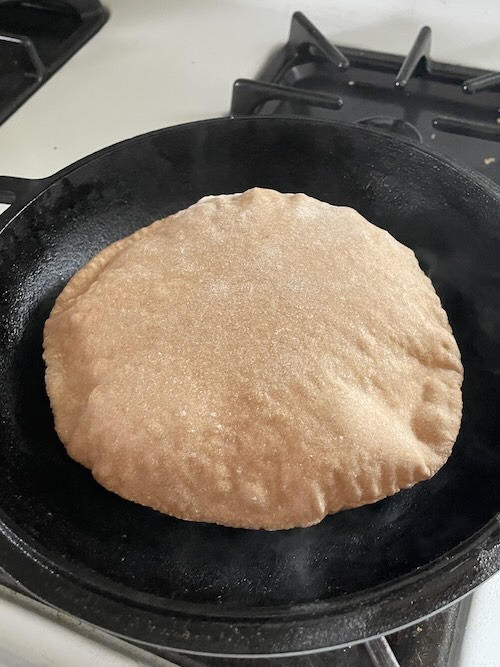
In fact, of the pita breads I cooked in my cast iron pan, the first couple puffed up nicely, but the subsequent pita breads gradually became worse and drier as the cast iron retained more heat.
Worst: baking in the oven (without baking stone or pizza stone)
In my tests for optimal pita cooking techniques, the oven produced the worst results. Without the help of additional equipment (like a baking stone), my gas oven did not get hot enough for optimal pita puffing.
I preheated my oven to (465 F), which is around as high as it can handle without setting off the fire alarm, which it nonetheless did set off, thereby causing the cats and I much stress and discomfort. My oven-baked pita bread not only did not achieve the desired charring/browning, but was also very hard and dry (like crackers). Like the cast iron pan, the pita bread became evenly brown and crunchy. An overall suboptimal experience.
When cooking flatbreads like pita, we really only want the heat source to come from the bottom. Because the oven is an enclosed space, the circulating heat made the top side of my pita bread quite hard, even before flipping. Despite placing the pita bread on the lowest rack, this was likely still not close enough to the heat source to provide the intense heat needed for rapid puffing. In fact, the oven baked pita bread may have hardened before it puffed up completely, thereby preventing further expansion.
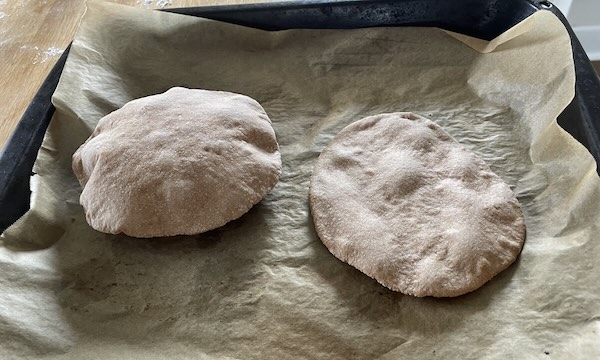
That is the problem with baking pita bread in a home oven. The conventional home oven does not get hot enough by itself. This can be remedied by preheating a baking stone or pizza stone. While I have heard success stories of pita baked using pizza stones, I cannot myself attest to their efficacy. Overall, I would not recommend baking pita bread in your home oven unless you have a pizza stone or a pizza oven.
Subscribe to my newsletter
(Sporadic) updates on new posts and recipes sent straight to your inbox.
Leave a Reply